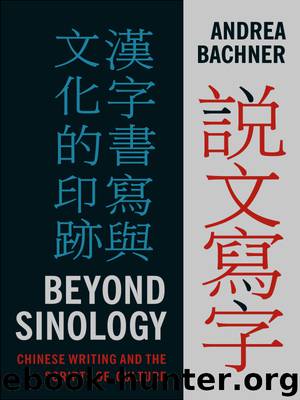Beyond Sinology by Andrea Bachner

Author:Andrea Bachner
Format: epub
Tags: -
Publisher: Columbia University Press
Published: 2013-11-19T16:00:00+00:00
Even faced with the danger of producing an incomprehensible text, the first-person narrator cannot desist from his politically inspired but pragmatically precarious use not only of the Chinese language, but, more importantly, of the Chinese writing system. We readers are thus reading a Chinese text that poses as a translation from the Malay of a text that its author (the text’s narrator) marks as written in precarious Chinese. Undecidability compromises total cultural and scriptural difference; Liu Cai’s scriptural loyalism forms the content of a text that suggests incommensurable versions of its written form: “Allah’s Command” poses either as Liu Cai’s first-person account, supposedly written in faulty, half-forgotten Chinese, or as the Chinese translation of a Malay original.
This draws attention to the author’s own predicament of sinographic inscription. On a plot level, he can stage the sinograph’s decentering and script its reinvention, however precariously. Nevertheless, on a metalevel he can merely hint at the fact that this reinvention can only happen through the literary medium of a fairly standardized sinograph. Only the mysterious fragment of two Chinese graphs transcribed into the text and the reader’s imagination of the monstrous graph that transcribes Liu Cai’s name emerge as unruly, elusive remains within a body of salvaged sinographs. Only these two spectral graphs really graphically mark a difference that exceeds the inevitable logic of marking difference through sameness, of salvaging the specificity of a Malaysian-Chinese literary articulation in and with the dominant tradition of the sinograph.
Ng’s text stages this complex scriptural incommensurability, but is written in relatively standard Chinese. If we reformulate this in terms of its scriptural politics, a complex constellation of graphic difference and sameness emerges. “Allah’s Command” is less interested in pitting alphabetic Malay and logographic Chinese against each other. Rather, graphic difference is shown at work in the Chinese script itself: Chinese writing becomes other to itself, as the sinograph becomes its own allograph. On the level of Ng’s text, the betrayed ideal is precisely the notion of a scriptural identity politics.
These examples activate Chinese writing as allography in different ways: digitalized Chinese is encrypted, the Chinese script is couched as the protoscript of tattooing, and Chinese writing is reinvented as crypto-Chinese, the production of a fake script that erases any possibility of a linguistic community, even as it desperately tries to inscribe “Chineseness.” These different allographies do not reinvest Chinese writing with an essentialist mystique, as a privileged script that magically anoints its inscriber with a Chinese identity. Instead, they put into motion processes of transcription that question the very boundaries of identity and alterity. Chinese—understood as an inscriptive tradition—is neither an unequivocal sign of identity for its wielder, nor the exotic other for those outside of its tradition. Instead, in its various contexts and material embodiments, the sinograph is constantly, though subtly, rendered other to itself—or, rather, other to a hallucination of its univocal essence. Allography as a theory of communication in transference, of encoding and decoding, is related to alterity only secondarily or perversely: it formulates a theory of signification in general while tarrying with the notion of the “other” writing.
Download
This site does not store any files on its server. We only index and link to content provided by other sites. Please contact the content providers to delete copyright contents if any and email us, we'll remove relevant links or contents immediately.
| African | Asian |
| Australian & Oceanian | Canadian |
| Caribbean & Latin American | European |
| Jewish | Middle Eastern |
| Russian | United States |
4 3 2 1: A Novel by Paul Auster(12286)
The handmaid's tale by Margaret Atwood(7679)
Giovanni's Room by James Baldwin(7192)
Asking the Right Questions: A Guide to Critical Thinking by M. Neil Browne & Stuart M. Keeley(5644)
Big Magic: Creative Living Beyond Fear by Elizabeth Gilbert(5614)
Ego Is the Enemy by Ryan Holiday(5294)
The Body: A Guide for Occupants by Bill Bryson(4974)
On Writing A Memoir of the Craft by Stephen King(4863)
Ken Follett - World without end by Ken Follett(4645)
Adulting by Kelly Williams Brown(4487)
Bluets by Maggie Nelson(4474)
Eat That Frog! by Brian Tracy(4436)
Guilty Pleasures by Laurell K Hamilton(4362)
The Poetry of Pablo Neruda by Pablo Neruda(4040)
Alive: The Story of the Andes Survivors by Piers Paul Read(3969)
White Noise - A Novel by Don DeLillo(3954)
Fingerprints of the Gods by Graham Hancock(3942)
The Book of Joy by Dalai Lama(3902)
The Bookshop by Penelope Fitzgerald(3777)
